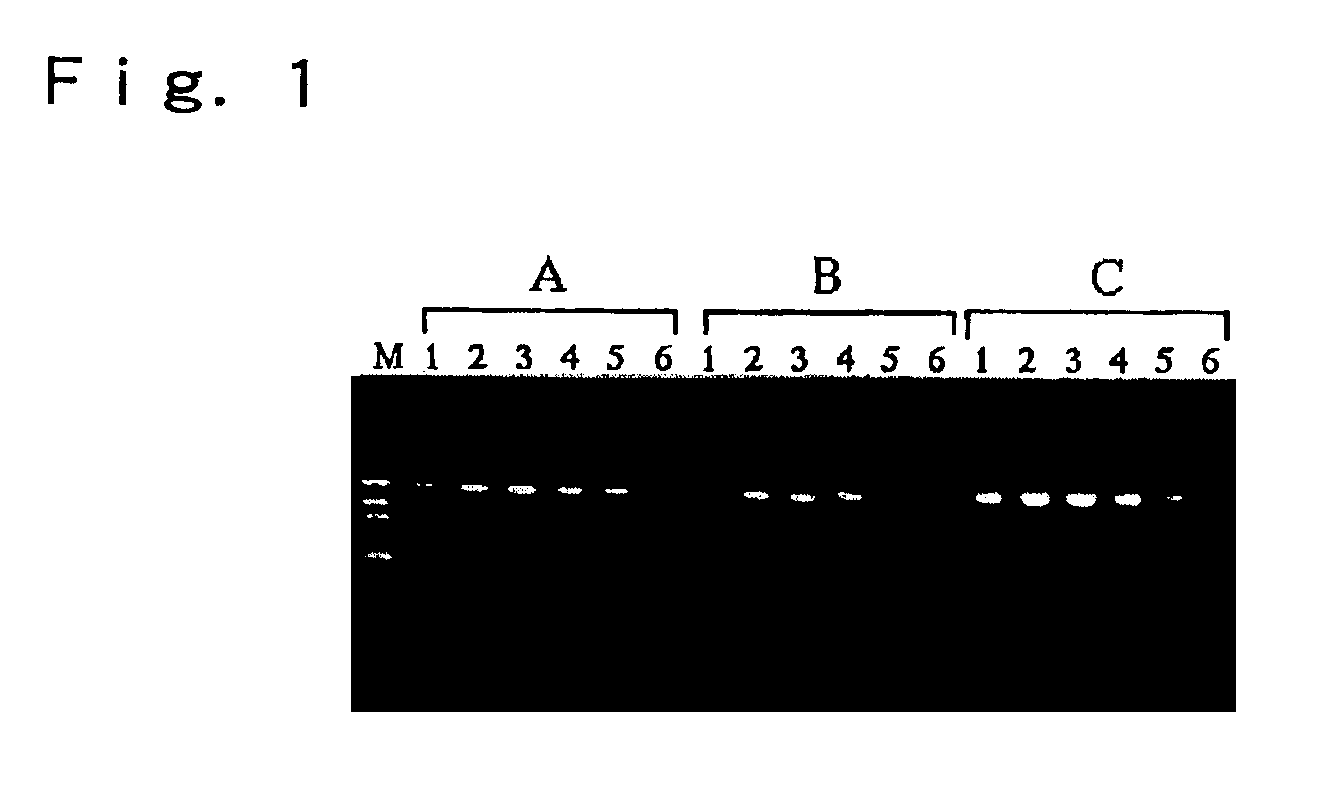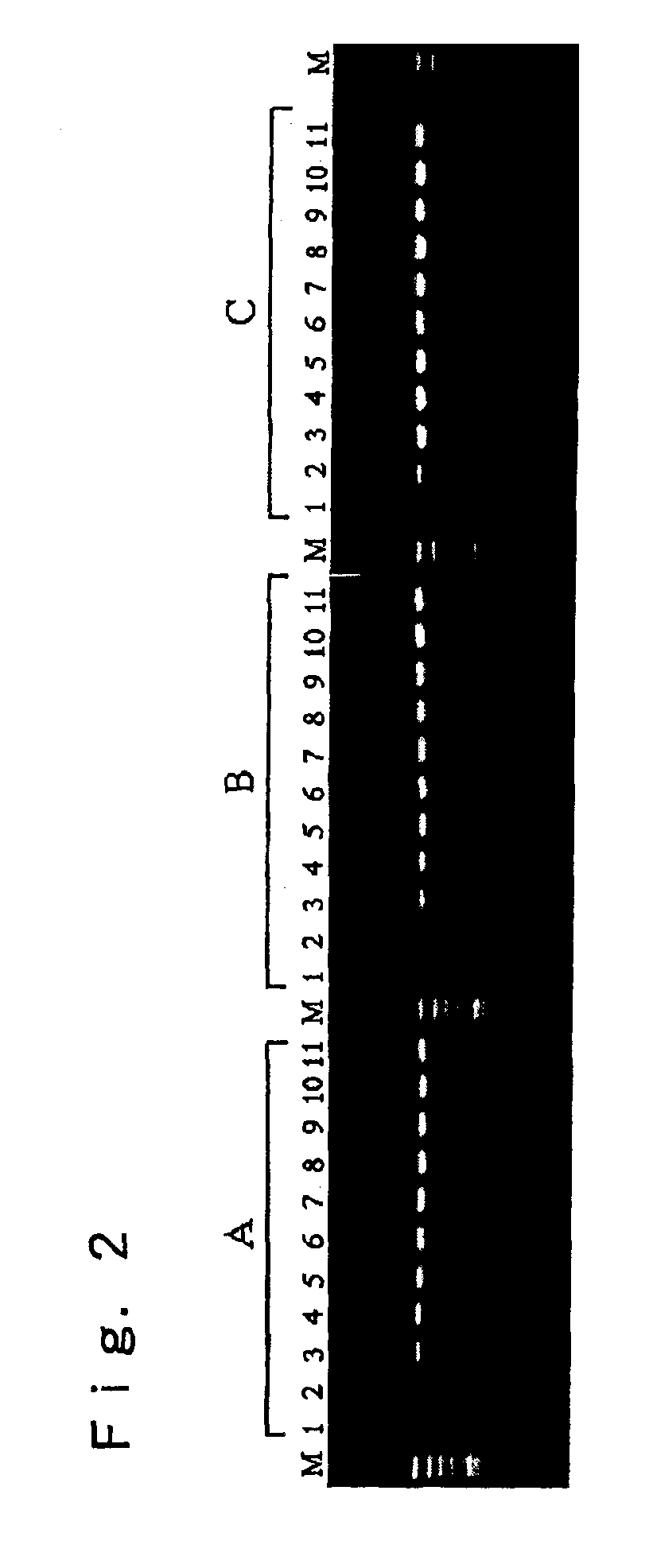Method for synthesis of nucleic acids
a nucleic acid and synthesis technology, applied in the field of nucleic acid synthesis, can solve the problems of difficult amplification and sometimes ineffective amplification of dna in samples, and achieve the effects of reducing the chance of contamination, and facilitating and rapid synthesis
- Summary
- Abstract
- Description
- Claims
- Application Information
AI Technical Summary
Benefits of technology
Problems solved by technology
Method used
Image
Examples
experimental example 1
[0039]To a PCR reaction solution (50.0 μl) was added 1.0 μl of a human blood treated with an anticoagulant (sodium citrate, EDTA-2K or Heparin-Na) to conduct the PCR. The PCR primers were oligonucleotides having a nucleotide sequence of the plus strand (P1, SEQ ID. NO. 1) and the minus strand (P2, SEQ ID. NO. 2) located within the HLA-A gene region, and these sequences were as below. As a result of the PCR using these two primers, 986 bp of an amplified product may be produced. Here, the GC content in this region is 68.6%.
[0040]
P1: 5′ GAAACSGCCTCTGYGGGGAGAAGCAA 3′P2: 5′ TGTTGGTCCCAATTGTCTCCCCTC 3′
[0041]The PCR reaction solution used was a reaction solution comprising 67 mM Tris-HCl adjusted at pH 8.8, 16.6 mM (NH4)2SO4, 2.0 mM MgCl2, 200 μM each of dATP, dCTP, dGTP and dTTP, 1.0 μM primers, and 2.5 units / 50 μl of Taq DNA polymerase (TaKaRa Z-Taq: Takara Shuzo, Kyoto, Japan) in which 0% to 20% of glycerin was added thereto.
[0042]The PCR involved a preheating at 96° C. for 3 minutes, ...
experimental example 2
[0045]This example describes an experiment in which pH values of the PCR reaction solution were adjusted to a range within 8.3 to 8.9 with 10% glycerin addition that afforded best amplification efficiency in the Experimental Example 1 to conduct the PCR. A sample used was the blood sample used in the Experimental Example 1. A composition of the PCR solution, a condition of the PCR and a condition of the electrophoresis after the PCR were the same as in the Experimental Example 1.
[0046]FIG. 2 shows the electrophoretogram of PCR products obtained by the PCR in which the PCR solutions adjusted to various pH values were used to conduct the PCR. In the figure, lanes A indicate the results obtained with the blood sample treated with sodium citrate; lanes B indicate the results obtained with the blood sample treated with EDTA-2K; lanes C indicate the results obtained with the blood sample treated with Heparin-Na; lanes 1 indicate results obtained with the PCR solution adjusted to pH 8.31; ...
PUM
| Property | Measurement | Unit |
|---|---|---|
| pH | aaaaa | aaaaa |
| pH | aaaaa | aaaaa |
| pH | aaaaa | aaaaa |
Abstract
Description
Claims
Application Information
 Login to View More
Login to View More - R&D
- Intellectual Property
- Life Sciences
- Materials
- Tech Scout
- Unparalleled Data Quality
- Higher Quality Content
- 60% Fewer Hallucinations
Browse by: Latest US Patents, China's latest patents, Technical Efficacy Thesaurus, Application Domain, Technology Topic, Popular Technical Reports.
© 2025 PatSnap. All rights reserved.Legal|Privacy policy|Modern Slavery Act Transparency Statement|Sitemap|About US| Contact US: help@patsnap.com


